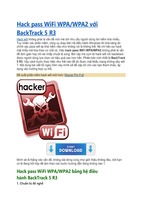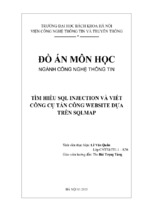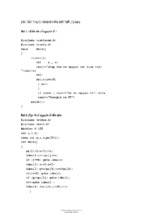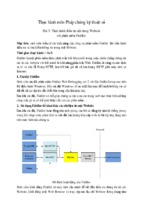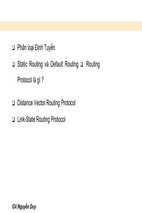•
•
•
facilities for simple terminal emulation to systems such as IBM's MVS/XA and
OS/400, UNIX, OpenVMS, etc.
Terminal servers. Many vendors of terminal servers allow MODEM connection
facilities which allow many dial-up user connections. These devices are
becoming more flexible as they not only offer the traditional terminal access
facilities for terminal emulation to mini's, supermini's, mainframes and
supercomputers, they also are supporting asynchronous access to TCP/IP's
SLIP and PPP protocols, AppleTalk, IPX, etc. The problem with this approach is
an extremely limited security access facility (it is frequently limited to a terminal
server-wide password which everyone has access to use), limited access
speeds, non-flexibility of hardware and limited user tracking and reporting.
"Small" routers. Many of the major router vendors are building small,
inexpensive router systems that provide asynchronous access facilities as well
as router access software to existing LAN and WAN resources. These provide
extremely limited security facilities, if any at all, but are useful due to their
inexpensiveness and ease of integration in to existing networks.
All-inclusive MODEM and remote access control systems. This is a relatively
new class of MODEM access security system that allows terminal emulation
facilities, remote protocol access capabilities, user authentication methods,
security facilities (passwords, accounting, session tracking, live monitoring,
exception handling, alarms, etc.), user menu facilities, user profile tracking and
multiple hardware facility access (Ethernet/802.3, token ring/802.5, FDDI, ISDN,
ISDN-B, ATM, etc.) all at the same time from the same facility. These types of
systems are complex and very capable and are rapidly becoming the system of
choice for sites with many differing types of dial-up requirements for many
different types of systems.
While this does not provide an all-inclusive list of access facilities, it serves as an
illustration of what has traditionally been available. Most of these tools are limited to
either a traditional RS-232, RS449, RJ11 or RJ45 interface to a given system. In
some of the server access facilities, Ethernet/802.3 or token ring/802.5 LAN access
are also supported for access to remote servers as well as local resources.
2.9.1 Tactical and Strategic Issues in Selecting a MODEM Connection Solution
In most sites considering dial-up facilities, the need is real and is not going away.
Many companies are becoming more mobile and the need for remote dial-up access
is becming critical. It is estimated in 1999 that over 60% of all computers that will be
sold will be notebook sized or smaller. This, coupled with the trend towards dockingstation systems that can be moved at will, provides a market for remote access that
is growing dramatically and does not show any signs of diminishing. Further,
practically all consumer-level computers come equipped with a 56kbps V.90
MODEM.
Where most sites fail in their tactical and strategic planning for such facilities is in
the expectation that they can contain the requirement for dial-up and that they can
dictate the user's options. What happens in many situations is the users will
implement their own solutions and not provide any feedback to IT facilities until it
has become firmly entrenched in the deliverable solutions for management. As a
result, the opportunity to control the unauthorized facilities is reduced to nil and the
IT groups must deal with a myriad of dial-up options based upon what was planned
and what happened "on its own."
From a tactical perspective, it is better to provide the solution in a manner that is
acceptable to the users before they have the opportunity to circumvent the dial-up
solution with a substandard solution that will be incorporated due to default access.
56
If dial-up solutions are in place, it is tactically wise to implement substitute solutions
that provide the following features:
•
•
•
•
Does not affect the user's computing budget. People always like something they
feel is "free."
Does not impose too much more additional effort to use
Provides a substantial improvement over the current method of dial-up such that
the new method is immediately attractive regardless of new user effort required
to use it
Allows greater user flexibility, speed and access facilities
While most of this is common sense, it is interesting how many companies provide
an inferior solution to current user access methods or a one-for-one solution which
irritates users with new procedures and facilities. No one wants to deal with a stepback in productivity or technology. Stepping forward, however, has to show a
reasonable increase in productivity or user-desired features or it will be
unacceptable as well.
From a strategic perspective, companies need to consider what dial-up protocols
will be required, speed of access to remote facilities and eventual hardware facilities
that will be used on internal and external networks. Many companies will start off
with LAN technologies such as Ethernet/802.3 and token ring/802.5 networks and
eventually implement 100mbps LAN/MAN technologies such as FDDI. This
eventually leads to the inevitable implementation of ISDN-B, ATM and SONET
access. Any remote access facility needs to be upgradeable to these environments
as the company requirement grow.
Of importance in the selection of any solution is the realization that MODEMs are,
technologically, on the way out as digital communications replace analog facilities in
the phone systems of the world. Some telecommunications providers already
provide direct ISDN and ISDN-B facilities which allow a technology called unbundled
ISDN services. In this offering, the local equipment company (the LEC), provides a
T1 connection to the customer site, divided into 24 separate 56kbps digital
channels. At the LEC, MODEM emulation is provided to a dial-up user which is
converted to a digital channel access to one of the channels to the customer. The
effect is that the customer does not need to purchase any MODEMs, the user
population can use existing MODEM technologies and when the phone system goes
pure digital in the future, there are no corporate MODEM banks to replace. Since
the trend is to go digital, the need to support ISDN, ISDN-B and ATM is crucial for
long term user satisfaction and in the support of alternate connection technologies in
the future.
2.9.2 Background on User Access Methods and Security
To access any system via terminal, a user is expected to enter, as a minimum,
some type of user identification (such as as user ID, username, or some other
identifier), a password, and other optional login information as may be required by
the systems or network manager. In some situations, an additional “system”
password is used before the user ID to allow the system to automatically detect
access baud rate as well as provide the user the opportunity to enter a general
access password in order to gain entry in to the system or front-end being used. To
enhance system security for dial-up access, other methods may also be added such
as digital ID cards, dial-back MODEMs that reconnect the user to the system after
the system dials the user back, and other types of electronic equipment security
denial or restricted access methods.
57
Some of the security flaws with this level of access in the general systems area are:
•
The steps above allow the opportunity to exploit flaws in the access method as it
is by rote, mechanical in nature, and easily analyzed
• Simple access methods simplify user access efforts, but do not keep general
security intact. Because users share information and also leave security access
information in compromising locations, the information must change or be
generally compromised
• Most system access methods are highly susceptible to an exhaustive attack
from the terminal access methods (dial-up, X.29, and others) via something as
small as a personal computer
• Many users are never physically seen by the systems personnel and their login
information is frequently transmitted to them via phone call or facsimile, which is
highly subject to be compromised
Few operating systems provide intensive monitoring and activity recording facilities
to help trace sources of intrusion and to also detect unauthorized usage
• Few companies trace employees who have left the firm and properly clean up
access methods for employees. The result are accounts that exist, sometimes
for years, before they are deleted or even changed.
• For companies with highly mobile employees or employees that travel
extensively, dial-back MODEM management is extensive and time consuming.
Further, within the next 12-24 months from this writing, many MODEM devices
will be rendered in-effective due to pure digital phone systems such as ISDN
coming on-line and replacing current analog offerings
• Dial-back MODEM units are not compatible, in some cases, with foreign system
access due to CEPT or ITU-T incompatibilities with phone systems (ITU-T
E.163 POTS and V series standards), carrier frequencies, DTMF tone levels,
and other electronic incompatibilities. As such, some dial-back systems will not
work with some foreign phone systems which can cause problems for a
multinational corporation.
• None of the current systems direct user logins to a specific destination; they
only restrict access to “a” system of some sort
• No current user interface logins allow for protocol security for asynchronous
connections via DECnet Phase IV, TCP/IP PPP or SLIP links, asynchronous
AppleTalk or other types of protocols that support an asynchronous interface
• Security encryption cards and other electromechanical interface devices are
frequently lost and are expensive to replace and manage
• Dial-back modems are subject to abuse by use of phone system features such
as call forwarding
For these reasons and others too numerous to mention in a short summary, the
author, Dr. Hancock, believes that many currently available commercial dial-up
access security products are inadequate for a secure information access method to
systems on a computer network.
With the rise of computer crime via dial-up access, there is a natural paranoia that
systems professionals are required to recognize: dial-up access makes system
access possible for non-authorized individuals and this exposure must be
minimized. The reasons for keeping non-authorized individuals out of customer
systems include:
•
•
•
•
Potential discovery and publication of sensitive internal memoranda
Industrial espionage
Destructive systems interference (”hacking”) by unauthorized individuals
Potential virus infestation from external sources
58
•
•
•
Isolation of company proprietary data from unauthorized individuals (such as
food and drug filings, patent data, primary research data, market information,
demographics, corporate financial data, test and research results, etc.)
Potential for external sources to “taint” valid data, causing the data to appear
valid and cause irreparable harm
Potential safety hazards if manufacturing or other production systems were
accessed from external sources and process control software were changed or
modified in some way
There are many other examples, but these give the general issues on why
restrictive connectivity is required at customer sites. Also, as recent as late 1993,
customer research centers have experienced multiple attempts at system
compromise from external sources via dial-up and X.29 terminal pad connection.
While no specific break-in was detected, the attempts have been numerous and
getting more creative with time. It was deemed necessary to improve terminal
connectivity security procedures.
Some customers have used dial-back MODEMs and hardware security cards for
user terminal access.
The dial-back MODEMs, while previously useful, are now easier to violate due to
new phone system facilities offered by regional telephone companies. Facilities
such as call forwarding, call conferencing and other facilities that will be offered via
Signaling System 7 (SS7) and Integrated Services Digital Network (ISDN)
connectivity facilities make the general functionality of dial-back MODEMs easier to
violate (dial-back facilities could be re-routed via the phone system to other
locations other than the phone number expected and desired) and a total lack of
security on the phone network itself helps to propagate this effort.
In recent months, the hackers magazine 2600 has published articles on how to
provide remote call-forwarding and how to “hack” public phone switching systems
and access a variety of information including call routing tables. With this type of
information, potential disruptors of corporate dial-up methods can forward calls to
any desired location.
A recent example is that of Kevin Poulsen in California, who successfully "hacked"
the local phone switch over a period of two years. The result was interesting. He
successfully made his personal phone line the only one able to gain access to radio
station lines and busy-ed out all other lines to make himself the winner of numerous
phone offers. His winnings included two Porches, two trips to Hawaii and over
$22,000.00 in cash. Investigation by the FBI showed that Poulsen accessed much,
much more than the stated "hacks" and was charged with a long list of crimes
including computer fraud, interception of wire communications, mail fraud, money
laundering, obstruction of justice, telecommunications fraud and others. His primary
vehicle was access to the telephone switching system, which effectively defeats any
type of dial-back facility which depends on the phone system to be "untouched."
Devices such as security identification cards, approximately the size of a credit card
and possessing verification algorithms that allow exact identification of a user, are
very secure provided that they are not shared between users. They are also
somewhat expensive (est. $60.00 per user) and are easily destroyed (sat upon,
placed in washing machines, etc.) or lost. Because of accounting problems and the
size of the dial-up population, some former employees have left customer’s employ
and taken their cards with them making recovery virtually impossible. There are also
some terminal connection facilities in which security identification cards will not work
and this requires another approach to the problem.
59
Such cards work by the user entering a number when prompted by the destination
system, in a specified amount of time, that is visible in an LCD window in the card.
This number is synchronized with the destination system and, algorithmically, the
number should decypher to a valid combination the system will accept.
Another type of security access method, called a token card, works on the concept
that the card cannot possibly be in any one else's possession. This is accomplished
by installation of token hardware and software in notebook computers and, in some
cases, in the inclusion in operating system ROMs on the motherboard of the remote
system. While secure and the loss levels are low, the costs are serious and severely
restrict the types of remote systems that may access a centralized dial-up method
as well as the type of dial-up or remote access method available.
In many circumstances there is the problem of identifying who has left the firm (and
when) so that their security card information may be removed from the access
database. At present, there are former customer employees that have left their firms
some time ago and are still identified as being active users in the security card
database. While this is mostly an accounting and tracking problem, there is no
automated “user X has not logged in via dial-up in Y amount of time” facilities to
allow tracking of user activity levels.
Even with proper accounting and user tracking, there is a recurring expense
required for the use of security identification cards (replacements, failed units,
damaged units, etc.) and this is growing due to the number of people desiring
access to the system resources at customer sites.
A major problem with security cards and token cards is the problem of user
accounting and session tracking. Many products provide a method by which users
may be accounted for in terms of access time and line identification, but that is
about it. There are no investigative tracking facilities, session tracking facilities,
session capture (for the extreme cases), user profiling and many other required
features for proper investigation of penetrations or improper activities.
What consumers require is an easy-to-use secure dial-up access method that
allows different types of terminal connection platforms (dial-up async, sync, X.29
dynamic PAD access, etc.) to customer system resources. Further, the system must
use off-the-shelf hardware to keep the short and long term costs of dial-up low and
support multiple terminal protocol facilities. Finally, the interface must have logging
and auditing facilities useful in user tracking and user access abnormality detection
by monitoring user activity profiles and reporting such information to systems
personnel for action.
2.9.3 Session Tracking and User Accounting Issues
In any dial-up solution, there is the need to provide reports on user access, where
the user connected and rudimentary reporting of times, activity levels and dates of
access for accounting facilities.
Where many companies find problems after implementation are the issues of
tracking down breaches of security or monitoring specific user activities for users
performing activities that are considered counterproductive to corporate goals or
illegal. Even if the system is successful in keeping out unwanted intruders, many
company security breaches are from employees or contractors working within the
company facilities. Tracking of activities is important when attempting to isolate
60
internal breaches, the most common type, and when trying to isolate illegal
activities.
Tracking may be done in a variety of manners. The easiest is when the system is
set up to detect deviations from established access and activity patterns and reports
alarms on deviations. Unfortunately, setting up such facilities is non-trivial in larger
dial-up environments where there may be hundreds or thousands of accounts. What
is needed is software facilities that will establish a normalization baseline on a userby-user basis and then provide a method to report anomalies and deviations from
established operations.
Once the dial-up system has detected deviations, reporting and session
management/capture facilities need to be activated to properly identify user actions
and track activities to the keystroke level. This provides a chain of evidence of
malfeasance and can be used to procecute a malicious user or to prove the
innocence of falsely accused users. Evidence is essential in any security breach or
suspected misuse of system and network resources. Keeping people off of systems
is not terribly difficult and there are well established manners in which this is done.
Tracking them, developing a reliable trail of activity patterns and evidence that may
be used for procecution is difficult and the system has to be designed from the start
to provide this level of information.
Reporting for user access needs to be very dynamic for the production of
accounting report for chargeback and also
2.9.4 Description of Proposed Solution to Dial-Up Problem
The author, has implemented various types of secure access systems for various
types of customers requiring dial-up network access without using dial-back
MODEMs. The most productive and flexible method to do this is to use an
intermediate network connection to provide connectivity and access services. This
may be accomplished through the use of a local Ethernet, terminal servers, and a
small 32-bit or 64-bit system to provide dial-up connection authorization.
Graphically, the connection path would appear as follows:
MODEM Pool
Terminal Server
Security Ethernet
Security access system
with two Ethernet
controllers to two
separate Ethernets
Main Backbone
Figure 1: Architectural Drawing of Secure Front-End Simple
Configuration
61
In a typical usage scenario, users dial up to a customer specified phone number
pool with V.32bis, V.34, V.90 or similar MODEMs (this allows 300 through 56Kbps
async dial-up). The number pool, due to the nature of the software, could be a tollfree access number (800-type in the U.S. and Canada) or a connection number and
ID on a public data network (X.25/X.29). The security access server(s) would then
automatically connect the user to special login security software that would ask for a
username, password, and any other type of required information. In this manner,
should it be necessary, a terminal emulation request, an asynchronous protocol
connection (such as PPP, SLIP or async AppleTalk) could be authorized or other
type of connection protocol. Following authorization and authentication of the user
over the dial-up connection, the security system software would connect the dialedup user to a system on the main Ethernet backbone at the customer’s site. This
would allow the secure access server system to provide very specific connection
facilities on a user-by-user basis and at the system and network manager’s
discretion. Based upon previous implementations at other facilities, this type of
connectivity would prove useful to customers where security is a serious concern
and yet remote access to the network and systems thereon is essential to fulfilling
corporate needs and goals.
Positive-acknowledgement systems, also sometimes called extended user
authorization systems (EUAS), are those that require user action to initiate
connection to or from a system. In the case of most customer sites, the system will
require the user to provide positive identification via the following methods:
•
Access password upon initial MODEM or system connection to the secure frontend in a manner similar (but not the same as) to many pre-user password
security methods. This allows connection but does not divulge the corporate
identity, which is usually the first place that a “hacker” would receive information
on what company is being attacked.
•
Specific pre-defined user ID and password through a special front-end system
on the dial-up Ethernet segment. This is designed in such a way as the user will
not be able to tell that he/she is actually connected to a security screening
system. This is provided to simplify the user access and not divulge system
identity or corporate identity as well as provide a highly secure access method.
•
Following identification look-up and acknowledgement (which will be done via
secure cryptography, not a hashing mechanism as used in most operating
systems or suggested in ITU-T X.509), the user will either be presented with a
menu of services he/she is allowed to access or connected to the only network
service he/she may be allowed to access. Since the menus are customizable,
the user will not be allowed to roam the network looking for connection points.
•
The user would then be required to log in to the destination system via normal
log-in procedures for that system.
An additional alternative is to use personal access cards on the remote systems
prior to connection. While user card access at the remote facility is desirable, the
ISO standard for such access is being experimented with at this time in X.72 and
X.75 standards (and, by default, X.25) and is having great difficulty in properly
forwarding the ID values. It is the opinion of the author that card access is definitely
desirable in the future but is much too immature for the variety of dial-up
connections and remote facilities that customer sites are expected to support.
Further, the ISO standard will most likely change in the next year which would cause
a re-write of any card access programming (this could get costly and delay any
62
upgrades for a considerable time). At a meeting of the ISO group working on the
X.75 test, serious problems were raised with the issues of secure cards and credit
card authorization facilities in public access networks and it was decided that a
considerable amount of additional work is required before these can effectively be
used for secure access.
As a side issue, a successful network break-in in France’s PTT Minitel videotex
system was accomplished by using a PC to emulate card key access. The PC was a
portable laptop and the program was written in Turbo C, a common and inexpensive
compiler. This has caused proponents of card and digital signature access to rethink how the formats of data are provided from the card access method.
2.9.5 Dissimilar Connection Protocols Support
One feature of remote access facilities are their ability to connect to remote systems
via network or async connection(s). The user may log in to the remote access
system and then be connected to a networked system on the corporate network in a
variety of ways.
Because of the manner in which terminal session management is done, some
remote access systems are capable of acting similar to a terminal “gateway”
between protocol types. This means that a user may connect via dial-up to the
remote access system and then request an SNA terminal connection to a
mainframe. A user from a remote UNIX system may connect with Telnet via the
network to the remote access system and then be re-connected by the system to an
Alpha AXP system using DECnet’s CTERM protocol.
2.9.6 Encryption/Decryption Facilities
Some remote access systems use the ANSI Data Encryption Standard (DES) for
encryption and decryption of files in U.S. installations and an exportable hashing
algorithm for installations outside the U.S. This is due to exportation of encryption
technologies laws in the U.S. and is not a reflection on the vendor's desire for
customers in the international marketplace to have less secure installations than
those in the U.S. The vendors in the U.S. have no control over this law and must
comply.
Some remote access products do not store sensitive files on disk in an unencrypted
manner. All screen captures, user information and other files that are sensitive in
nature are encrypted in real-time and stored on disk in an encrypted form. Should
files be backed-up and moved to another system, the files will be unintelligible when
printed or sent to a terminal screen.
Remote access products with session and information capturing facilities have the
ability for a system manager to store captured data for a user in a file. When stored,
the file buffers are encrypted prior to being written to disk. If the system manager
wishes to view the file, the file is retrieved from disk and decrypted “on-the-fly” and
viewed with a special encrypt/decrypt editor.
2.9.7 Asynchronous Protocol Facilities
Secure remote access servers often provide the ability for the system manager to
set up specific user accounts for asynchronous DECnet access, TCP/IP's SLIP
protocol, asynchronous AppleTalk and others. The user must go through the
standard security login dialog and, when the user has been authenticated, the line is
automatically modified and converted to an asynchronous protocol port. Some
63
systems allow multiple protocol access and a user menu may be provided for
access to various protocol services.
2.9.8 Report Item Prioritization
One of the more aggravating items in generation of reports is having to wade
through the amount of paper generated to find truly significant events and take
appropriate action.
Some remote access servers allow the system manager to set priorities (critical,
urgent and routine) on various data items in the system. In this manner, as security
exception reports are generated they may be printed in priority order. When a
security exception report is read by the systems or security manager, the report may
be organized such that high-priority items are at the beginning of the report,
precluding a search operation to find what is truly important in the report.
2.9.9 User Profile “Learning” Facility
When designing secure remote access servers, the author found that one of the
worst situations was the lack of knowledge of who logged in to systems “when.”
While some operating system environments could allow the system manager the
flexibility to specify login times to be at specific times of the day, these facilities are
very rarely used as it was deemed too difficult to set up and figure out what times of
the day the user is active.
Some systems now have an autoprofiling feature, which may be enabled for the
entire system or on a user-by-user basis. This allows the secure access server to
“learn” how a user interacts with systems on the network. The secure access server
collects activity levels and time of day parameters, stores them and sets up,
automatically, an activity profile for the user. If the user attempts to log in to the
secure access system at times not specified by the profile, access is denied.
Further, if operating parameters during a login session exceed the learned “norm,”
the user may be disconnected. Obviously, there are user-by-user overrides
available to the system manager that may be set-up to allow individual user
flexibility. For large user count sites, this feature has proven to be very valuable and
allows establishment of activity patterns and detection of abnormalities (this is the
first step to detecting illicit connectivity).
2.10 Network Security
1. Ensure that any message sent arrives at the proper destination.
2. Ensure that any message received was in fact the one that was sent. (nothing
added or deleted)
3. Control access to your network and all its related parts. (this means terminals,
switches, modems, gateways, bridges, routers, and even printers)
4. Protect information in-transit, from being seen, altered, or removed by an
unauthorized person or device.
5. Any breaches of security that occur on the network should be revealed, reported
and receive the appropriate response.
6. Have a recovery plan, should both your primary and backup communications
avenues fail.
Things to consider in designing a network security policy (as covered earlier).
1. Who should be involved in this process?
2. What resources are you trying to protect? (Identify your assets)
64
3. Which people do you need to protect the resources from?
4. What are the possible threats? (Risk assessment)
5. How important is each resource?
Unless your local network is completely isolated, (standalone) Your will need to
address the issue of how to handle local security problems that result from a remote
site. As well as problems that occur on remote systems as a result of a local host or
user.
What security measures can you implement today? and further down the road?
*Always re-examine your network security policy to see if your objectives and
network circumstances have changed. (every 6 months is ideal.)
2.10.0 NIST Check List
NIST Checklist for functions to consider when developing a security system The
National Institute for Standards and Technology (NIST) has developed a list for what
they refer to as Minimal Security Functional Requirements for Multi-User
Operational Systems. The major functions are listed below.
1. Identification and authentication - Use of a password or some other form of
identification to screen users and check their authorization.
2. Access Control - Keeping authorized and unauthorized users from gaining
access to material they should not see.
3. Accountability - Links all of the activities on the network to the users identity.
4. Audit Trails - Means by which to determine whether a security breach has
occurred and what if anything was lost.
5. Object Reuse - Securing resources for the use of multiple users.
6. Accuracy - Guarding against errors and unauthorized modifications.
7. Reliability - Protection against the monopolization by any user.
8. Data Exchange - Securing transmissions over communication channels.
2.10.0.0 BASIC LEVELS OF NETWORK ACCESS:
1. Network Supervisor- has access to all functions including security.
2. Administrative Users- a small group given adequate rights to maintain and
support the network.
3. Trusted Users- users that need access to sensitive information.
4. Vulnerable Users- users that only need access to information within
5. their job responsibilities.
2.10.1 Auditing the Process
Making sure your security measures work is imperative to successfully securing
your data and users. You have to make sure you know who is doing what on the
network. Components of a good audit will include;
1. A log of all attempts to gain access to the system.
2. A chronological log of all network activity.
3. Flags to identify unusual activity and variations from established procedures.
65
2.10.2 Evaluating your security policy
1. Does your policy comply with law and with duties to third parties?
2. Does your policy compromise the interest of your employees, your company or
third parties?
3. Is your policy practical, workable and likely to be enforced?
4. Does your policy address all of the different forms of communication and record
keeping within your organization?
5. Has your policy been properly presented and agreed to by all concerned parties?
With adequate policies, passwords, and precautions in place, the next step is to
insist that every vender, supplier, and consultants with access to your system
secure their computers as adequately as you secure yours. Also, work with your
legal department or legal advisors to draft a document that upon signing it would
recognize that the data they are in contact with is yours.
2.11 PC Security
One of the most critical security issues, one that has been compounded by the
micro and LAN/WAN revolution, is a lack of awareness, by executives and users, to
the vulnerability of their critical and sensitive information. Microcomputers have
unique security problems that must be understood for effective implementation of
security measures. These problems include;
•
•
•
•
•
•
Physical Accessibility
Hardware
Software
Data Communications
Networking
Disaster Recovery
Physical Accessibility
Several approaches need implementing in order to provide the necessary security
for microcomputers.
•
•
•
•
•
Hardware Solutions
Locks
Desk Mounts
Enclosures
Steel Cables
Disk locks are also available to prevent access to hard drives and diskette drives.
Planning and diligent administration are the keys to securing microcomputers and
the information they process.
An increasing problem in most organizations is microcomputer and/or component
theft involving personnel within the company as well as outsiders. Some of these
components are easy to carry away in a purse, briefcase, or coat pocket.
Organizations that lack accurate or current inventories of their PC equipment,
components and peripherals are the most vulnerable.
A situation similar to automobile "chop shops" has become prevalent in the PC
industry. Black market sales of "hot" PC parts are costing corporate America over $8
billion a year.
66
Things to consider in regards to system security
1. Can the Casing on the equipment be removed by unauthorized personnel.
2. Are notebook and laptop computers secured to desktops.
3. Is peripheral equipment such as CD ROM readers, tape back up units and
speakers secured to desktops.
4. Are floppy drives secure from the introduction of unauthorized software, viruses
or the removal of confidential corporate information.
Software Solutions
Viruses have left a number of corporations sadder but all the wiser. A virus can
change data within a file, erase a disk, or direct a computer to perform
system-slowing calculations. Viruses may be spread by downloading programs off
of a bulletin board, sharing floppy diskettes, or communicating with an infected
computer through a network, by telephone or through the Internet. Anti-virus
products are a necessity for the detection, eradication and prevention of viruses. In
addition, micro security policy should define permissible software sources, bulletin
board use, and the types of applications that can be run on company computers.
The policy should also provide standards for testing unknown applications and limit
diskette sharing.
Data Residue is data that is stored on erased media. Such data can often be read
by subsequent users of that media. This presents a danger in sharing files on
diskettes that once contained sensitive or confidential data. This problem also exists
for hard drives. One solution available to companies is the use of degausser
products. Primarily used by the US government, corporate America is now finding
these effective tools for preventing the disclosure of sensitive information.
2.12 Access
2.12.0 Physical Access
Restrict physical access to hosts, allowing access only to those people who are
supposed to use the hosts. Hosts include "trusted" terminals (i.e., terminals which
allow unauthenticated use such as system consoles, operator terminals and
terminals dedicated to special tasks), and individual microcomputers and
workstations, especially those connected to your network. Make sure people's work
areas mesh well with access restrictions; otherwise they will find ways to circumvent
your physical security (e.g., jamming doors open).
Keep original and backup copies of data and programs safe. Apart from keeping
them in good condition for backup purposes, they must be protected from theft. It is
important to keep backups in a separate location from the originals, not only for
damage considerations, but also to guard against thefts.
Portable hosts are a particular risk. Make sure it won't cause problems if one of
your staff's portable computer is stolen. Consider developing guidelines for the kinds
of data that should be allowed to reside on the disks of portable computers as well
as how the data should be protected (e.g., encryption) when it is on a portable
computer.
Other areas where physical access should be restricted is the wiring closets and
important network elements like file servers, name server hosts, and routers.
67
2.12.1 Walk-up Network Connections
By "walk-up" connections, we mean network connection points located to provide a
convenient way for users to connect a portable host to your network.
Consider whether you need to provide this service, bearing in mind that it allows any
user to attach an unauthorized host to your network. This increases the risk of
attacks via techniques such as IP address spoofing, packet sniffing, etc. Users and
site management must appreciate the risks involved. If you decide to provide
walk-up connections, plan the service carefully and define precisely where you will
provide it so that you can ensure the necessary physical access security.
A walk-up host should be authenticated before its user is permitted to access
resources on your network. As an alternative, it may be possible to control physical
access. For example, if the service is to be used by students, you might only
provide walk-up connection sockets in student laboratories.
If you are providing walk-up access for visitors to connect back to their home
networks (e.g., to read e-mail, etc.) in your facility, consider using a separate subnet
that has no connectivity to the internal network.
Keep an eye on any area that contains unmonitored access to the network, such as
vacant offices. It may be sensible to disconnect such areas at the wiring closet, and
consider using secure hubs and monitoring attempts to connect unauthorized hosts.
2.13 RCMP Guide to Minimizing Computer Theft
2.13.0 Introduction
Increasingly, media reports bring to light incidents of thefts occurring in offices at
any time of the day or night. Victims include government departments, the private
sector and universities in Canada and in the United States. The targets: computers
and computer components. Perpetrators include opportunists, petty thieves, career
criminals, organized gangs, people legally in contact with the products, e.g.
transportation and warehouse workers, as well as individuals working in the targeted
environment.
While incidents of this nature have increased dramatically in the last few years, the
number of reported incidents reflect only a portion of the total number of
occurrences. One reason for this is that government institutions, the private sector
and universities alike are often reluctant to report such incidents, for fear they’ll be
ridiculed or that their operations will be negatively affected.
Advances in electronics and the miniaturization of components have provided
thieves with ideal targets — expensive items that are easily concealable, readily
marketable and hard to trace. Components can be transferred from thief to
middleman to a distributor without anyone knowing they are stolen. Items such as
cellular phones, laptops, integrated circuits, electronic cards, disk drives and CDROMs have become the target of choice of both novice thieves and career
criminals.
This publication identifies the primary areas of vulnerability that may lead to loss of
assets (computer components) and proposes safeguards designed to minimize the
risks of losing these components. Samples of physical security devices are
described, and strategies are offered for minimizing computer and component theft.
68
2.13.1 Areas of Vulnerability and Safeguards.
2.13.1.0 PERIMETER SECURITY
Minimizing Perimeter Security Vulnerabilities
Examining the perimeter security of a building is the first step and involves
establishing appropriate safeguards, through target hardening. Target hardening is
the process of setting up a series of physical barriers (protection) to discourage an
adversary’s progress. The objective is to have an adversary either give up the idea
of an attack, give up during the attack, or take enough time for a response force to
react to the attack before its completion. A building’s entrances exits and trade
entrances are vulnerable areas that should be the focal point for enhanced
perimeter security.
The following checklist can help determine the security posture of the perimeter:
•
•
•
•
•
•
•
•
Is the building secured at ground or grade level by locked doors, using heavyduty commercial hardware (locks, hinges)?
Are the windows at ground level either fixed or locked with heavy-duty
commercial hardware?
Are trade entrances locked or controlled or are they wide open to strangers?
Are rooftop openings locked with heavy-duty commercial hardware if accessible
from outside the building?
Does the building have an outside ladder? If so, is the ladder secure?
Is it protected with a ladder barrier to prevent unauthorized access to the roof?
Do employees work during the evening?
Is there sufficient lighting surrounding the building, including the parking lot and
service entrances?
Examples of Enhanced Perimeter Security Safeguards
•
•
•
•
•
•
Alarm grade level doors and windows against opening and breakage.
Ensure day and night security patrols are conducted by security personnel.
Monitor the building perimeter by CCTV.
Install entry security controls for single-tenant facilities, or in facilities shared
with other government departments requiring the same level of security.
Whenever possible, avoid multi-tenant buildings where private tenants do not
want entry controls.
Surround the building with tamper-proof lighting fixtures. Position the security
lighting to prevent deep shadows from the building or vegetation, so intruders
can be noticed.
2.13.1.1 SECURITY INSIDE THE FACILITY
Minimizing Vulnerabilities Inside the Facility
Once the building perimeter has been secured, the next important step is controlling
personnel, visitors and equipment entering and exiting the building. One effective method
to maximize the control and usefulness of security staff is to have all employees and
visitors enter the facility through one entry point, with material entering at another
identified entry point. It is recognized that with high-occupancy or multi-tenant buildings it
may not be practical to have a single entry point. Departments providing services to the
public should be located on the main floor, to limit access to working areas. Only
authorized employees and supervised visitors should have access to operational areas.
All service vehicles should enter the site through a single vehicle control point. Canteens,
lunch rooms and stores should be designed and situated such that deliveries to and from
69
such areas do not have to enter the secure perimeter. Every facility should have a
reception zone, accessed directly from the public-access zone, where visitors, if
necessary, wait for service or for permission to proceed to an operational or secure zone.
If this process cannot be accommodated then each floor must be secured. Other security
vulnerabilities include the improper use of a guard force and granting unlimited access to
all areas of the building’s working or technical areas, e.g, electrical and telephone rooms.
Examples of Enhanced Safeguards Inside a Facility
• Establish reception points at interface points between functional groups or
secure zones.
• Do not use stairs forming part of a means of egress to enter office environment.
• Establish access controls, either manually, mechanically or electronically.
• Establish different public access zones, operational zones and security zones.
• Clearly define the limits to which public access is permitted, through signage.
• Control access to floors through short distance stairs (i.e. circulation stairs)
running between floors.
• Do not allow elevators to stop on all floors during silent hours, unless persons
have been granted access by key, access card or the entry control desk.
2.13.2 Physical Security Devices
Minimizing Vulnerabilities Using Physical Security Devices
Physical security devices are another method of preventing unauthorized use,
intentional damage or destruction, or theft of computer equipment and components.
Many different devices are available on the market, including alarms, locks, cabinets,
cable kits, lock-down plates and special security screws. One company has marketed
theft retrieval software that notifies police of a stolen PC’s whereabouts. The use of
security seals tamper-evident labels and ultraviolet detection lamps is also being
implemented.
The RCMP has not endorsed these products, other than containers, because the
majority have not been tested to evaluate their effectiveness. Some of the products
may be useful, but may not be cost-effective. In many instances, it is more costeffective to protect the working area than it is to tie down or alarm each PC.
Labelling, engraving and ultraviolet detection is time-consuming to implement; and
inventory has to be kept up-to-date. In addition, there is little to indicate that these
methods will reduce thefts. Laptops and portable computers are usually stolen for
personal use or for resale. The buyer knows the item has been stolen but is willing
to take the chance of receiving stolen goods because of the low price and the
improbability of being caught.
2.13.2.0 EXAMPLES OF SAFEGUARDS
Cabinets enclose the entire computer, including the monitor, keyboard, printer and
CPU. Cabinets are usually metal or composite materials, making them difficult to
break into. Information on approved cabinets is available from Public Works and
Government Services Canada.
70
Alarms are installed either inside or outside each CPU unit. The alarms do not
prevent the theft of computer equipment but they usually act as a deterrent. In
addition, people in the vicinity or at a central location are alerted by a loud piercing
sound if the equipment is moved or if the alarm is tampered with.
Anchoring pads and cables are used to anchor devices to desks and tabletops,
using high-strength adhesive pads or cables. Once the pad is installed on the table
or desk, it is very difficult to remove, and the adhesive usually ruins the finish.
Cables are probably the most common physical securing devices, and the least
expensive. Steel cables are passed through metal rings that are attached to the
equipment and a desk or table. Although cables prevent anyone from quickly
walking away with a piece of equipment, they can be cut. Another anchoring method
is the use of steel locking plates and cables to secure a variety of computer
components and office equipment to desks or tables. The bottom plate is either
bolted to the desk or fastened with adhesive. The top and bottom plates slide
together and are secured with a high-security lock.
71
Secure lid locks help prevent intrusion into PC servers and routers and protect
microprocessors and memory chips. The metal construction is crushproof, with no
adhesive or cables to damage the equipment.
Secure drive locks prevent the introduction of external viruses to PCs and networks,
avert the removal of sensitive corporate files by unauthorized individuals, deter the
introduction of unauthorized software to PCs and networks and prevent booting from
the floppy drive.
72
Security software uses anti-theft retrieval encryption stealth technology to locate
stolen computers. Upon a customer’s report of computer theft, the company initiates
its tracking feature. As soon as the stolen computer is connected to a telephone
line, the software turns off the modem’s speaker and silently dials the company’s
tracking line, giving the PC’s current location. The company then informs law
enforcement officials, who can obtain a search warrant and retrieve the computer.
2.13.3 Strategies to Minimize Computer Theft
Computer theft cannot be eliminated, but can be reduced by implementing a few simple
strategies.
2.13.3.0 APPOINTMENT OF SECURITY PERSONNEL
Departments must appoint a departmental security officer (DSO). The DSO should have
direct access to the deputy head to report probable security breaches and illegal acts, as
warranted and in accordance with the DSO’s mandate. The DSO is responsible for
developing, implementing, maintaining, coordinating and monitoring a departmental security program.
2.13.3.1 MASTER KEY SYSTEM
An appropriate master key system must be developed, and comply with the following
guidelines:
•
•
•
All perimeter doors should be keyed alike and not placed on the master key
system.
Restricted access areas should be keyed differently and not placed on the
master key system.
All utility rooms should be keyed alike, in groups.
73
2.13.3.2 TARGET HARDENING
Minimizing Vulnerabilities Through Target Hardening
Target hardening creates an environment, which makes it difficult for the aggressor to
reach a target. The goal of target hardening is to prevent a successful attack through the
use of barriers to reduce the adversary’s speed of progress, leading to the adversary
either giving up the idea of an attack, or taking enough time that a response force can
react.
Examples of Enhanced Target Hardening Safeguards
•
•
•
•
•
•
•
Increase the number of barriers.
Increase penetration delay time by strengthening barriers, e.g., doors. The
adversary loses speed moving from one barrier to the next due to the weight of
the equipment necessary for penetration.
Increase the time needed to reach an asset, to augment the chances of
detection and response. To get full delay time from any barrier, a detection
device must detect suspicious activity at first contact with the barrier, rather than
after it has been breached.
Compartmentalize facilities to develop progressively restrictive zones. Every
facility should have a reception area where visitors wait for service or
permission to proceed to a more restricted area.
Control circulation of persons and equipment by having all individuals and
materials enter through two distinct control points; one for employees and
visitors and the other for service vehicles and trade personnel.
Physically separate zones with a wall extending from the true floor to the true
ceiling, including a door equipped with an approved auxiliary deadbolt for use
during silent hours.
Ensure elevators open in a public reception area. Uncontrolled opening of an
elevator on a floor is permissible if access to the floor is continuously monitored
or if the floor is secure at all times. After business hours, elevators should be
controlled by the entry control desk. To further enhance security, elevators
should not stop on floors unless persons have been granted access by the entry
control desk, or have a key, card or other access device.
2.13.4 PERSONNEL RECOGNITION SYSTEM
2.13.4.0 MINIMIZING VULNERABILITIES THROUGH PERSONNEL
RECOGNITION
A personnel recognition system is based on the visual identification of individuals known
to authorized personnel or control staff. This system depends solely on personal
knowledge of the individuals having access to a particular facility or zone. For this system
to be effective, it is necessary to comply with the following guidelines:
•
•
•
•
For ease of recognition, the number of employees should not exceed
100 per shift, unless the personnel recognition system has dedicated
control staff, i.e., the same guard works the day shift from Monday to
Friday.
There must not be a high turnover of control staff.
The control staff must recognize all the personnel they will be required
to identify prior to assuming control functions.
The control staff must be advised immediately upon resignation or
termination of an employee, to prevent former employees from entering
at any time except under escort.
74
•
Identification cards must be available for presentation, if necessary.
Examples of Personnel Recognition System Safeguards
•
•
•
Issue an identification (ID) card to all employees. An ID card should contain the
individual’s photograph, name and signature, the name of the issuing
department, a card number and an expiry date. The individual’s screening level
can also be displayed, if desired, unless a Threat and Risk Assessment (TRA)
recommends otherwise.
Issue a building pass or access badge to employees who require regular access
to restricted areas, indicating their authorization to enter specific zones.
Allow for additional processes to verify identity, where warranted.
Procedures for ID Card or Authorization Badge Use
Departments using ID cards or authorization badges must develop procedures for their
use, including:
•
•
•
•
•
•
•
Establishing a log for the issuance and recovery of both identification
cards and access badges, in which is recorded the date of issue, the
identity of the bearer, the number of the card or badge, reliability level of
the bearer, expiry date and the recovery date of the card or badge;
Establishing a process for verifying the authenticity of cards or badges
held by personnel;
Providing guidelines for the withdrawal of either cards or badges for
cause;
Indicating how to report improper use, damage, loss or theft of cards or
badges;
Ensuring retrieval of employee cards or badges upon termination of
employment;
Ensuring all blank inserts and equipment necessary for issuing cards
and badges are physically protected. The protection should be at a level
equal to that of the classified or designated information and assets to
which they will indicate authorized access; and
Ensuring the destruction of all expired or damaged cards and badges.
2.13.5 SECURITY AWARENESS PROGRAM
2.13.5.0 POLICY REQUIREMENTS
The Security Policy of the Government of Canada (GSP) requires that departments
implement a security awareness program for all personnel, to define their security
responsibilities. Security awareness training is an essential element of a
comprehensive and effective security program. Such training is a continuing series
of activities, with two overall objectives:
•
•
Keep staff aware of their responsibilities and role in implementing and
maintaining security within the department; and
Obtain and maintain the commitment of staff to those responsibilities and
actions. To be effective, security awareness training must be continually
reinforced, through the use of periodical newsletters, bulletins and lectures
to all personnel.
Without the full cooperation of management, the security awareness program will
not succeed and the employees will not cooperate. In these times of restraint, the
75
- Xem thêm -





